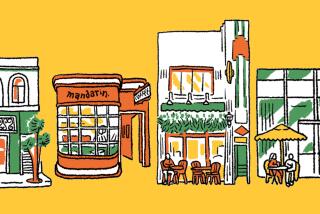Italian Firms Savor U.S. Cappuccino Boom : Coffee: It’s meant a big increase in business for the manufacturers of both commercial and home espresso makers.
- Share via
MILAN — Guido Bernardinelli remembers the first time he forked over $11 for three espresso coffees and croissants in the U.S.--twice the price he would have paid back home in Italy.
*
“I was shocked,” he said. “But I sure am happy they can charge those sort of prices. It means there’s good demand.”
Bernardinelli has reason to be happy. He’s in charge of U.S. exports for Cimbali SpA, Italy’s largest maker of professional coffee machines.
Coffeehouses and specialty restaurants run by companies such as Starbucks Corp. of Seattle, Sbarro Inc. of Commack, N.Y., and Vie de France Corp. of McLean, Va., have sprung up across the United States, giving Americans a taste for lounging over a cup of cappuccino and other Italian-style coffees.
Each cafe, however, needs special machines to make the brew. Italian producers have largely cornered that market, and the U.S. coffee boom has been a lucrative boom for them as well.
The number of professional coffee machines sold in the United States more than doubled to 19,500 from 9,000 between 1991 and 1994, according to the Italian trade association UCIMAC. The value of the sales rose to $30 million from $11 million.
Italian producers have more than 70% of that market. The rest was split among other European manufacturers, as well as some small, privately owned U.S. companies.
In addition to perking up profits, the U.S. coffee boom has been a testing ground for Italian makers. U.S. consumers’ special demands have led to new features and new machines, which Italian manufacturers say will help them expand the coffee boom to places such as Japan and Australia.
*
The United States last year leapfrogged France to become the second-largest market for professional coffee machines, soaking up 14% of the world’s output. Italy, with 250,000 cafes, remains in first place with 20%, but its market isn’t growing.
“Traditional markets, such as Italy and France, are saturated,” said Gianpiero Rossi, owner of Brasilia and the current president of UCIMAC.
In those mature markets, Brasilia sells mostly replacement machines--”and with the economy weak, many are holding on to their old machines,” Rossi said. “But that’s been more than balanced by strong growth abroad, principally in the U.S.”
Besides Cimbali and Brasilia, Italy’s five big professional coffee machine makers are Faema SpA, La San Marco, C.M.A., and Rancilio. With the exception of Faema, the companies are family-owned; all are based in northern Italy. There are another roughly 30 smaller makers.
On average, they export 75% of their production.
*
Italian coffee machines have long been exported to America, but until a few years ago most buyers were coffee bars in ethnic neighborhoods or tony restaurants in the big cities.
That started to change in the 1980s, when the first espresso coffee outlets sprouted in Seattle and San Francisco, then spread nationwide.
Ted Lingle, executive director of the Specialty Coffee Assn. of America in Los Angeles, said the number of coffee bars has grown from under 200 in 1989 to 4,000 now. He sees 10,000 by 1999.
“This is not just a fad,” he said. “This is here to stay.”
Espresso is made by forcing steam through deeply roasted, finely ground and densely packed coffee beans, producing a stronger, richer brew than the drip-filter method traditionally used in the United States.
The method was invented in Italy at the turn of the century, though few of the original machines--with their copper heating tanks and exposed tubes, valves and levers--remain.
The steam produced by the machine also is used to froth milk, which is splashed on top of the coffee to make cappuccino.
But that’s where the similarity between Italian and American coffee culture ends.
Italians gulp espresso in one go as an energy fix. Americans like to get take-out or lounge around the coffee shop.
Americans also prefer cappuccino, drinking nine frothy ones for every espresso. In Italy, the proportion is reversed.
“When we started selling in America, we quickly noticed Americans do things differently,” said Maurizio Cimbali, the third-generation president of Cimbali. “They want cappuccino to be boiling hot because they are going to take it in their car with them and drink it 30 minutes later.”
They also want larger, weaker drinks than Italians prefer.
The newer Italian machines incorporate these features--and automate the process.
Cimbali’s Bernardinelli said about 7% of the machines he sells in the U.S. are fully integrated--that is, they grind the beans, make the coffee and add frothy milk at the push of a button. In value terms, automated machines are about 20% of Cimbali’s U.S. sales.
*
Brasilia’s Rossi said espresso machines that use prepackaged “pellets” of coffee are going to lead the industry’s growth in the years ahead, even in Italy. The simplicity of pellet machines makes them more appealing to small restaurants, opening a new market segment.
Italian companies also dominate the world market for home espresso machines, sales of which also are booming in the U.S.
The coffee association’s Lingle said there’s a strong link in America between the growth of coffee bars and the new interest in drinking espresso at home, with each reinforcing the other.
Coffee shops such as Starbucks often sell the machines in their stores as a way to increase sales of beans.
According to Italian trade association ANIE, exports from Italy to the United States almost tripled to 138,000 machines in 1994 from 52,000 machines the year before.
The United States accounted for almost all of 1994’s increase in exports to 827,000 pieces, or 97.5 billion lire’s worth, from 731,000 pieces or 69 billion lire the year earlier.
About 80% of Italy’s production is exported.
There tends to be little crossover between the production of professional and home-use espresso machines because they are sold to a completely different set of customers, and because the margins are much thinner for smaller, cheaper, and more common domestic machines.
The largest Italian makers of home coffee machines are De Longhi, Rieti, Gaggia, and Saico; all are family-owned. One of their biggest competitors is Robert Krups GmbH, a division of Moulinex SA of France.
Almost all coffee machine makers only assemble parts made by other, mostly Italian companies. Some U.S. companies, though, have profited from the coffee boom. Honeywell Inc. of Minneapolis and Parker-Hanifin Corp. of Cleveland make valves, for example, while Procon makes the pumps used in some Italian machines.
More to Read
Inside the business of entertainment
The Wide Shot brings you news, analysis and insights on everything from streaming wars to production — and what it all means for the future.
You may occasionally receive promotional content from the Los Angeles Times.










